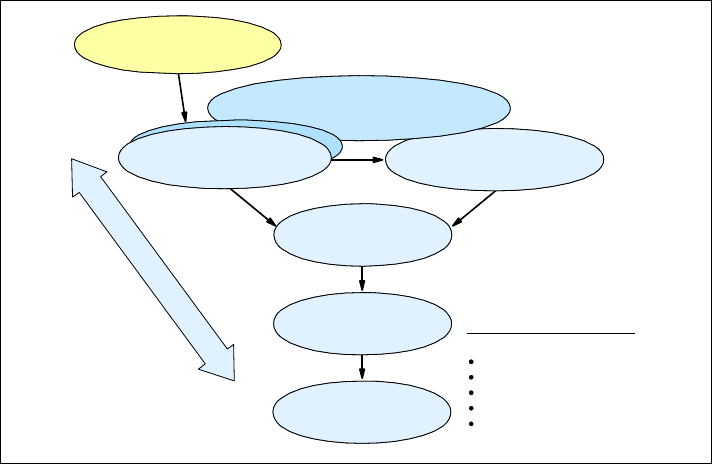Appendix A. Patterns for e-business 431
drivers) to Business patterns that have already been documented. The patterns
provide tangible solutions to the most frequently encountered business
challenges by identifying common interactions among users, business, and data.
Senior technical executives can use Application patterns to make critical
decisions related to the structure and architecture of the proposed solution.
Application patterns help refine Business patterns so that they can be
implemented as computer-based solutions. Technical executives can use these
patterns to identify and describe the high-level logical components that are
needed to implement the key functions identified in a Business pattern. Each
Application pattern would describe the structure (tiers of the application),
placement of the data, and the integration (loosely or tightly coupled) of the
systems involved.
Finally, solution architects and systems designers can develop a technical
architecture by using Runtime patterns to realize the Application patterns.
Runtime patterns describe the logical architecture that is required to implement
an Application pattern. Solution architects can match Runtime patterns to
existing environment and business needs. The Runtime pattern they implement
establishes the components needed to support the chosen Application pattern. It
defines the logical middleware nodes, their roles, and the interfaces among these
nodes in order to meet business requirements. The Runtime pattern documents
what must be in place to complete the application, but does not specify product
brands. Determination of actual products is made in the product mapping phase
of the patterns.
In summary, Patterns for e-business captures e-business approaches that have
been tested and proven. By making these approaches available and classifying
them into useful categories, LOB executives, planners, architects, and
developers can further refine them into useful, tangible guidelines. The patterns
and their associated guidelines enable the individual to start with a problem and
a vision, find a conceptual pattern that fits this vision, define the necessary
functional pieces that the application will need to succeed, and then actually build
the application. Furthermore, the Patterns for e-business provides common
terminology from a project’s onset and ensures that the application supports
business objectives, significantly reducing cost and risk.
The Patterns for e-business layered asset model
The Patterns for e-business approach enables architects to implement
successful e-business solutions through the re-use of components and solution
elements from proven, successful experiences. The Patterns approach is based
on a set of layered assets that can be exploited by any existing development

432 End-to-End e-business Transaction Management Made Easy
methodology. These layered assets are structured so that each level of detail
builds on the last. These assets include:
Business patterns that identify the interaction between users, businesses,
and data.
Integration patterns that tie multiple Business patterns together when a
solution cannot be provided based on a single Business pattern.
Composite patterns that represent commonly occurring combinations of
Business patterns and Integration patterns.
Application patterns that provide a conceptual layout describing how the
application components and data within a Business pattern or Integration
pattern interact.
Runtime patterns that define the logical middleware structure supporting an
Application pattern. Runtime patterns depict the major middleware nodes,
their roles, and the interfaces between these nodes.
Product mappings that identify proven and tested software implementations
for each Runtime pattern.
Best-practice guidelines for design, development, deployment, and
management of e-business applications.
These assets and their relationship to each other are shown in Figure A-1.
Figure A-1 Patterns layered asset model
Best-Practice Guidelines
Application Design
Systems Management
Performance
Application Development
Technology Choices
Integration
patterns
Composite
patterns
Customer
requirements
Business
patterns
Application
patterns
Runtime
patterns
Product
mappings
A
n
y
m
e
t
h
o
d
o
l
o
g
y
Get End-to-End e-business Transaction Management Made Easy now with the O’Reilly learning platform.
O’Reilly members experience books, live events, courses curated by job role, and more from O’Reilly and nearly 200 top publishers.

